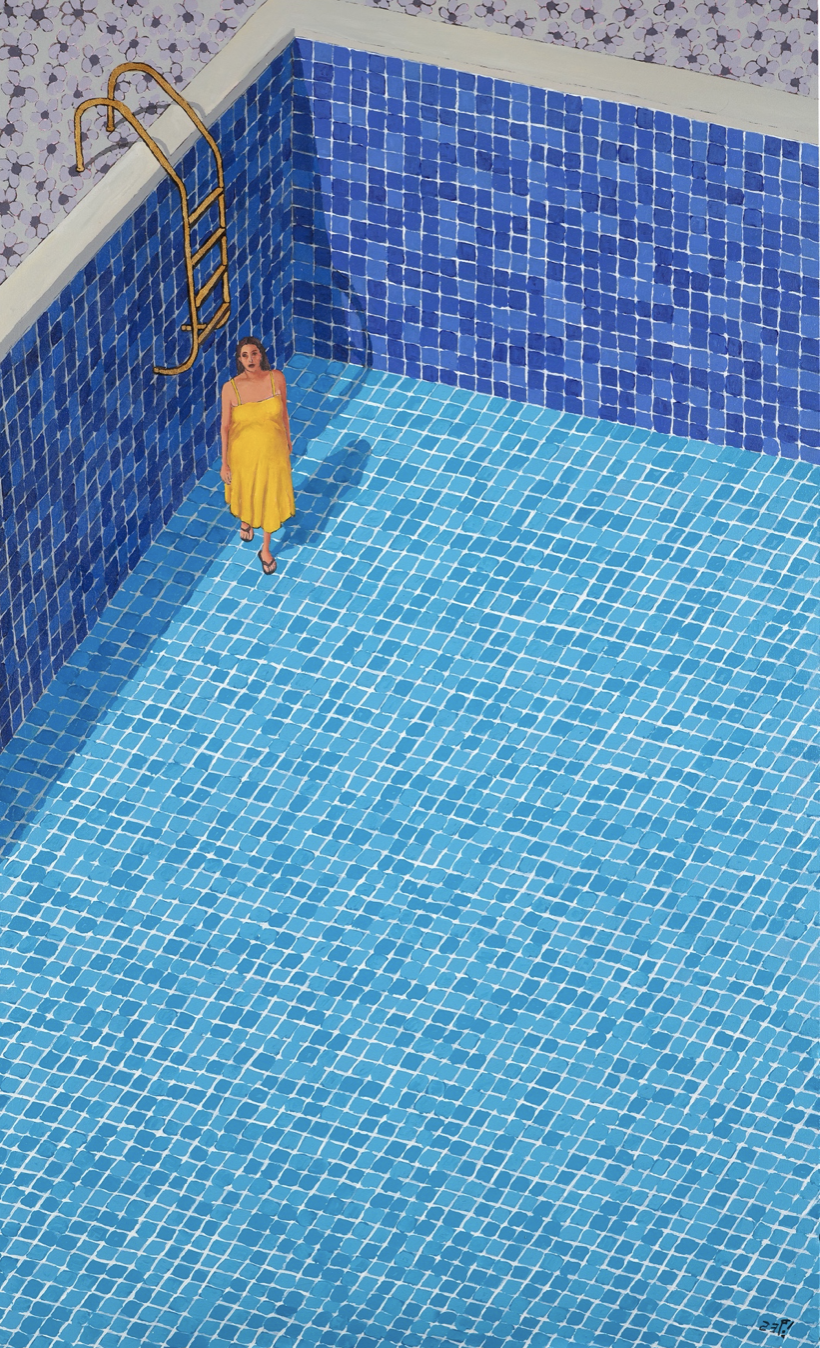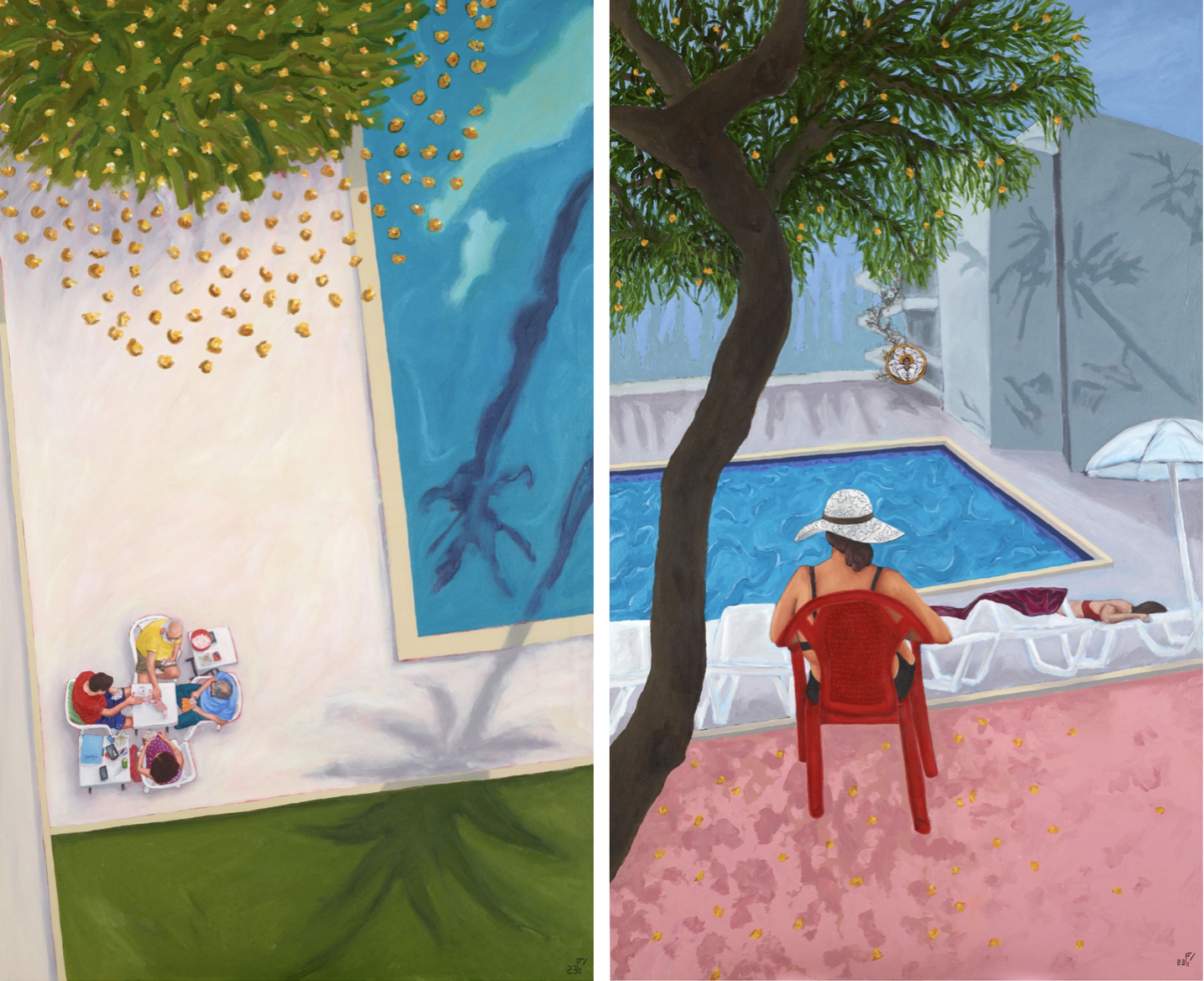
Most are painted on canvas and a few smaller pieces on woven jute. Swimmers, ripples on the surface of swimming pools, cypresses casting long shadows, empty lounge chairs, a group of four in casual wear seen from atop playing a game of cards, limbs transmogrified by the refraction of light in water, yellowish motel- like structures with forgettable architecture, extreme perspectival views, but also and more importantly, nights and days, a seraph in a medallion quizzically dangling from a flowery tree, gold leafed pool ladders, an empty pool basin with blue tiles that defy perspectival orthogonal construction, a woman floating supine with a tracery of wings weaving with the ripples of the water, a man floating prostrate with outstretched arms forming with his shadow a double crucifixion: At Rim El Jundi’s latest exhibition two questions press — where are we and when is it?
Look at the painting titled The Texture of Water, after which the exhibition is named. It announces what the many water-filled swimming pools tend to defer. A woman, wearing a comfortable looking yellow summer dress with flip- flops, dispassionately looks out towards the viewer. She seems to have descended onto the floor of the empty swimming pool without much effort. Behind her the pool ladder shines in gold leaf. We are looking down towards her as she seems to take a step on the cerulean-blue ceramic tile floor away from the ultra-marine shades of the visible pool walls. She casts a shadow as do the pool ladder and the pool wall on her right. The pool deck is pictorially flattened with a pattern of flowers in lilacs and lavenders whereas the grid of variegated ceramic tiles that establish the planes of the pool basin disconcertingly disobey the rules of perspective. The square tiles in front or towards the back are all equally measured. On one hand, the painting yields to the conventions of depicted space with cast shadows, tint variations, perspectival lines and a modeled solitary figure, while on the other hand denying those conventions with the gold leafed pool ladder, patterned pool deck and an absence of perspectival recession.

Right - Fig 3: Rim El Jundi, The Guardian of the Tree, 2023. Acrylic and mixed media on canvas,150 x 90 cm.
This painting come forth in the exhibition as a visual directive with which to see what the other works, or at least the larger canvases, proffer. For it must be said, up-front and unequivocally, that if a viewer visits this exhibition in search of a painterly ability in depicting the rippling surfaces of water, of swimmers’ bodies partially deformed by light and water and of skins painted with a chromatic complexity, they will be disappointed. As a painter, Rim El Jundi is more persistent than fluent. Her acrylic surfaces tend to tense-up when painting faces, limbs and details. Her figures are taut, almost stiff and their skin tones are often pasty and tonally modeled. When laying colors over larger areas of her picture plane she tends to apply her colors separately with little interaction. In other words, even when a painting shows many colors there is very little light that is generated by their contiguity. (One notable exception in this exhibition is Sunny Day at the Pool.1) This is not meant to underrate El Jundi’s art but more to better understand what sort of painter she is. The luscious application of painterly surfaces, or even any attempt at doing so, is always arrested and checked by patterning, stenciling, an extra-diegetic appearance of signifiers such as goldleaf and seraph, and an anti- realistic affect that belies the apparent naturalism.

In A Tree Sheds its Flowers for the Lucky One (fig. 2) four leisurely card players sit together while dark shades of palm trees obliquely cut downward through the picture plane from the right side and the green crown of a tree seen from atop disperses its blossoms outward and downward in a gradual orderly pattern towards the players. The card players are inattentive to a world turned upside down as if to welcome the miracle of this giving tree. This same tree, or at least one of a similar kind, hangs its flowery crown over a sinewy trunk that travels upward towards the left-hand upper corner in The Guardian of the Tree (fig.3). The tree has no shadow to cast. Beneath it sits a woman on a red plastic chair, her head covered with a patterned hat flattened against the modulated blues of the pool while another woman surrenders prostrate on her chaise-longue partially covered with a crimson towel under an umbrella that affords no protection from the sun. All the signifiers of a realistic representation are there but all are painted without weight. Very few shadows give form to humans and objects. It is as if the visible world was again arrested by an event that for the time of the painting is still not fully recognized: An apparition of a seraph on a medallion that precariously hangs from the drooping end of an unidentified climber plant.

More subtly, in Old Sins Cast Long Shadows (fig. 4) high rising cypresses cast dark shadows over the empty pool even as the sky is grey dark and cloudy. The deck and the balconies of the two flanking structures betray no human presence lest for the disarranged lounge chairs and, once again, apparitional strewn and over-sized golden leaves. This world of seeming leisure is porous to an otherworldly reality that calls on the viewer to see it as allegorical. The pool is also and more significantly a baptismal basin and a tranquil tomb. Trees are emissaries, pool ladders are guiding angels, men, women and children are malleable with limbs deforming and coalescing and can walk on the floor of pools as if empty, and just in case all these signs are missed a seraph appears to remind that this small motel resort is elsewhere, somewhere close to the company of the gods.
Allegorical, the art of Rim El Jundi abandons the edicts of naturalism and is at its most compelling when color is allowed to exceed visual familiarity. The unique night painting in the exhibition begins to do so. In Sanctuary (fig. 5) the pool water migrates towards the richer hues of phthalo, and viridian greens and a wider range of yellows and ochres animate the motel structure that seems to be looking like a custodian over the liquifying body of the swimmer. In this painting, the narrative initiated by the descent of the solitary woman into the disconcerting empty pool finds its closure. We are in a sacred place, as the title of the painting says. Without a sun, the night seems endless, and the swimmer is home. Soon, limbs, trunk and head will undo and join the gentle ripples of the water. And we, viewers, are left alone, envious at the sight of this one who found a gentle death, a tranquil departure, while here, on this side, most are extinguished by sudden and violent deaths.
Exhibition Details
Rim El Jundi - The Texture of Water
1 August- 31 August 2024. Agial Gallery, Beirut